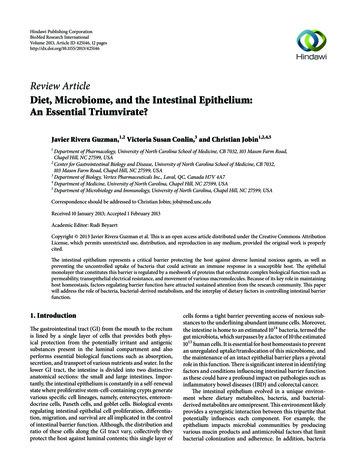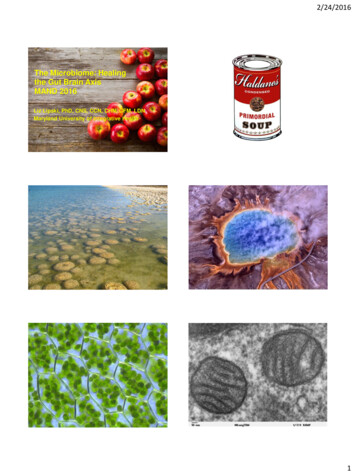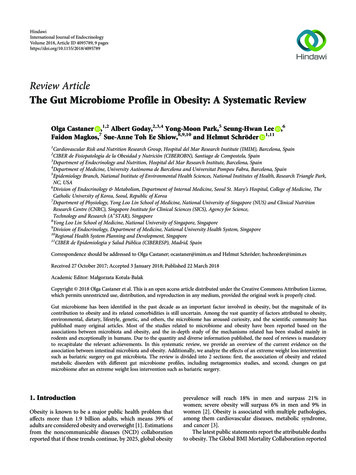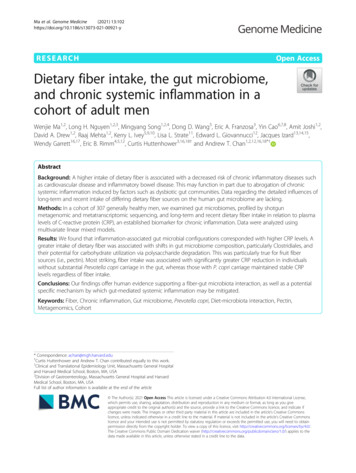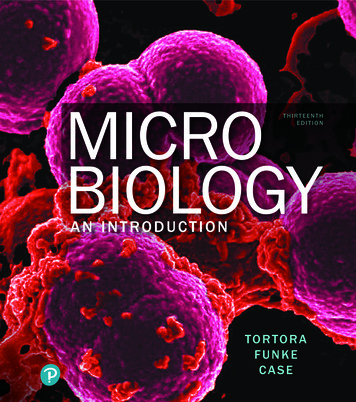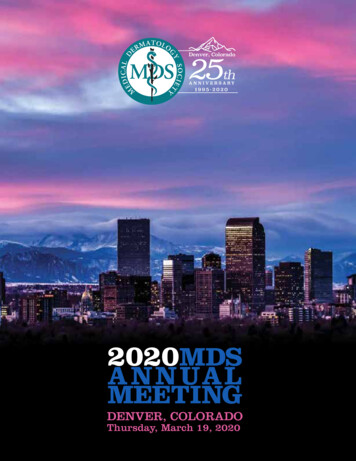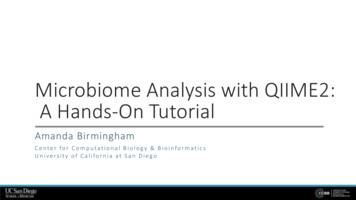
Transcription
Microbiome Analysis with QIIME2:A Hands-On TutorialAmanda BirminghamC e nte r fo r C o m p u tatio n a l B io lo g y & B io in fo rm aticsU n ive rs ity o f C a lifo rn ia at S a n D ie g o
Software Selection Google “16S analysis program name ”; main contenders are Mothur Name: not an acronym (play on DOTUR, SONS)Philosophy: single piece of re-implemented softwareTop pro: easy to installTop con: re-implementations could be buggyLanguage: C Model: open-sourceLicense: GPLPublished: 2009Developed: at Umichigan
Software Selection Google “16S analysis program name ”; main contenders are QIIME Name: Quantitative Insights Into Microbial EcologyPhilosophy: wrapper of best-in-class softwareTop pro: extremely flexibleTop con: QIIME 2 not yet feature-completeLanguage: python (wrapper)Model: open-sourceLicense: mixedPublished: 2010Developed: At UCSD, NAU
Software Selection Google “16S analysis program name ” Main contenders are Mothur and QIIME Both widely used Both pride themselves on quality of support Will discuss only QIIME in this tutorial QIIME 1 vs QIIME 2 QIIME 1 is no longer supported (since end of 2017) This tutorial uses QIIME 2 only I’m not a QIIME 2 developer I’m not taking credit for this tool, justdemonstrating it! Today’s practicum is an expansion of the QIIME2“Moving Pictures” tutorial
Prologue: Tuning Show of hands, please: How many have analyzed 16S data before? How many know what the “command line” is? How many are comfortable with unix shell commands?
Approach: Practicum on 16S analysis with QIIME 2 Alternating lecture and tutorial on command-line software Suggest you pair up with a partner Two eyes are better than one for finding mistakes and patterns Use the provided post-it notes to signal your status None—command not yet completed Green—command completed, no problems Red—having problems! Red post-its will be visited by my lovely assistant J
Get Ready To Practice! “Why are you making me type?!” QIIME 2 has a GUI—but still under development QIIME 2 command-line interface is easy to install and ready to run Typing is better than copy/pasting commands because in your real analyses, you willneed to type in the appropriate commands for your data§ Need to make realistic typing mistakes now so you know how to correct them later!
Tips to Help When typing a file name or directory path, you can use tab completion Start typing file/directory path, then hit tab—if only one file/directory matches what youalready typed, shell fills that in§ Very helpful for correctly entering long file names§ If 1 matches, shell fills in as much as it can Press up arrow to get back previous commands you typed If you type a command, press enter, and “nothing happens”, don’t just run it again Many unix commands produce no visible output to shell—just get back command prompt That doesn’t mean they do nothing, so running them *again* can screw up results Do not store commands in a word processing program (or PowerPoint, etc)§ E.g., MS Word changes hyphens to “m dash”—which command line can’t understand Shell commands are case-sensitive
Getting Data Data acquisition method is project-specific Public data can often be pulled down from internet with wget or curl commands Sequencing data from a core usually available by ftp§ Can use browser, Cyberduck, Filezilla, etc If all else fails, use a flash drive J
Getting Data (cont.) For today’s tutorial, we will use public data from the QIIME2 websitemkdir qiime2-moving-pictures-tutorialcd qiime2-moving-pictures-tutorialwget -O "sample-metadata.tsv" pictures/sample metadata.tsv"mkdir emp-single-end-sequenceswget -O "emp-single-end-sequences/barcodes.fastq.gz" "wget -O "emp-single-end-sequences/sequences.fastq.gz" z"wget -O "gg-13-8-99-515-806-nb-classifier.qza" -515-806-nb-classifier.qza"
Making a Mapping File “Mapping file” contains metadata for study Must contain info needed to process sequences and test YOUR hypotheses QIIME 1 required certain columns in certain order, but QIIME 2 is more flexible Tab-separated text file with column labels in first line at least one data line§ Column label values must be unique (i.e. no duplicate values) First column is the “identifier” column (sample ID)§ All values in the first column must be unique (i.e. no duplicate values) See https://docs.qiime2.org/2017.6/tutorials/metadata/ The easiest way to make a mapping file is with a spreadsheet But Excel is not your friend!§ Routinely corrupts gene symbols, anything interpreted as a dates, etc, & isn’t reversible
Practicum: Viewing A Mapping File Open Terminal For below, remember to try tab completion! Ensure you are in the tutorial directory:§ qiime2-moving-pictures-tutorialsource activate qiime2-2018.4lsnano sample-metadata.tsv Stretch the window so you can look at the contents; then, to close, typeCtrl x Mapping file errors can lead to QIIME 2 errors—or worse, garbage results! Keemei (pronounced ‘key may’) tool checks for errors in Google Sheets§ Chrome only, and must have Google account to use; see http://keemei.qiime.org/
Mapping File View
Common Issues in Marker Gene Studies Neglecting metadata Analysis can not test for effects of, or discard bias from, categories you didn’t record! Picking novel 16S primers—not all created equal Earth Microbiome Project recommends 515f-806r primers, error-correcting barcodes Not taking precautions to support amplicon sequencing Some Illumina machines require high PhiX, low cluster density Selecting an inappropriate reference database E.g., Greengenes (16S) reference database when sequencing ITS Expecting species-level taxonomy calls Most sequence variants only specify to family or genus level Using inappropriate statistical tests Taxa abundance requires a compositionality-aware test like ANCOM Differences in β diversity distances across groups requires test like PERMANOVA, not ANOVA
Importing Data After sequence data is on your machine, must be imported to a QIIME 2 “artifact” Artifact data metadata QIIME 2 artifacts have extension .qza Different kinds of input data (e.g., single-end vs paired-end) and different formats ofinput data (e.g., sequences & barcodes in same or different file) need different imports§ See “Importing data” tutorial at https://docs.qiime2.org/
Practicum: Importing Dataqiime tools import \--type EMPSingleEndSequences \--input-path emp-single-end-sequences \--output-path emp-single-end-sequences.qza Backslash is line continuation Could leave out and just type whole command as one run-on line J Note structure of arguments to qiime command Plugin name then method name then arguments§ Order matters
QIIME 2, https://qiime2.org.Demultiplexing Must assign resulting sequences to samples to analyze You may not need to do this! If sequencing done by a core, results may be demultiplexed before returned to you
Practicum: Demultiplexingqiime demux emp-single \--i-seqs emp-single-end-sequences.qza \--m-barcodes-file sample-metadata.tsv \--m-barcodes-column BarcodeSequence \--o-per-sample-sequences demux.qza Arguments have a naming convention Inputs (--i- whatever ), metadata (--m- whatever ), parameter (--p- whatever),output (--o- whatever ) Order doesn’t matter
Practicum: Demultiplexing (cont.) Presumably you’d like to know how your demultiplexing worked But the artifact doesn’t show you that info, so create a visualizationqiime demux summarize \--i-data demux.qza \--o-visualization demux.qzv Note that visualizations have the extension .qzv instead of .qza Now view the visualization, locallyqiime tools view demux.qzv When done examining, in Terminal, type JUST q Don’t need to hit Enter afterwards Beware: quitting visualization doesn’t close web page (but page becomes unreliable)
Demultiplexing Summary View
Demultiplexing Summary View (cont.)
Demultiplexing Summary View (cont.)
Practicum: Peeking At An Artifact What happens if you typeqiime tools view demux.qza
Practicum: Peeking At An Artifact (cont.) What happens if you typeqiime tools view demux.qza You getUsage: qiime tools view [OPTIONS] VISUALIZATION PATHError: Invalid value: demux-filtered.qza is not a QIIME 2Visualization. Only QIIME 2 Visualizations can be viewed Instead, runqiime tools view demux.qza
Practicum: Peeking At An Artifact (cont.) What happens if you typeqiime tools view demux.qza You getUsage: qiime tools view [OPTIONS] VISUALIZATION PATHError: Invalid value: demux-filtered.qza is not a QIIME 2Visualization. Only QIIME 2 Visualizations can be viewed Instead, runqiime tools view demux.qza See something SampleData[SequencesWithQuality]Data format: SingleLanePerSampleSingleEndFastqDirFmt
Aside: Viewing Artifact Provenance Provenance tracking is absolutely critical to reproducible analyses Almost no tool actually tracks it for you—really a fantastic new QIIME 2 feature Provenance can be viewed through the QIIME2 View website Open Chrome and go to https://view.qiime2.org Drag and drop file demux.qza Click on “Provenance” tab
Aside: Viewing Artifact Provenance (cont.) Click on square to see action details Click on circle arrow to see filepassed between actions Note that citations are also provided!
Quality ControlBokulich, N. et al. (2013). Quality-filtering vastly improves diversity estimates from Illumina amplicon sequencing.Nat Methods, 10(1), 57–59.QIIME defaults: r 3 q 3 p 0.75 n 0 c 0.005% or 2
Practicum: Quality Controlqiime quality-filter q-score \--i-demux demux.qza \--o-filtered-sequences demux-filtered.qza \--o-filter-stats demux-filter-stats.qza
Practicum: Quality Control (cont.)qiime quality-filter q-score \--i-demux demux.qza \--o-filtered-sequences demux-filtered.qza \--o-filter-stats demux-filter-stats.qzaqiime metadata tabulate \--m-input-file demux-filter-stats.qza \--o-visualization demux-filter-stats.qzv
Quality Control Summary View
Practicum: Feature Table Creationqiime deblur denoise-16S \--i-demultiplexed-seqs demux-filtered.qza \--p-trim-length 120 \--o-representative-sequences rep-seqs.qza \--o-table table.qza \--p-sample-stats \--o-stats deblur-stats.qza This can take up to 10 minutes to run, so while we wait Where do you guess the number 120 came from?
Practicum: Feature Table Creationqiime deblur denoise-16S \--i-demultiplexed-seqs demux-filtered.qza \--p-trim-length 120 \--o-representative-sequences rep-seqs.qza \--o-table table.qza \--p-sample-stats \--o-stats deblur-stats.qza
Feature Table Creation—The Past Last year: OTU (Operational Taxonomic Unit) “an operational definition of a species used when only DNA sequence data is available” Sequences at/above a given similarity threshold considered part of the same OTU§ 97% is the usual “species-level” threshold Similarity determined using alignment (time-consuming)§ Purpose is to minimize impact of sequencing errors But also masks fine (sub-OTU) variation in real biological sequences Results very difficult to compare across studies if done de novo§ “Closed reference”, “open reference” methods increase comparability require reference database Output is a “feature table”:§ Rows are samples§ Columns are OTUs (arbitrary identifiers if de novo, from reference database if closed reference)§ Values are frequency of reads from that OTU in that sample
Feature Table Creation—The Present This year: sOTU (sub-OTU) methods Use error modeling to in silco correct sequencing mistakes§ Sounds impossible but is actually quite accurate, with right error model Error model is specific to the sequencing type (e.g., 454, Illumina Hi/MiSeq) Result: only sequences likely to have been input to the sequencer Options include (NOT a complete list):§ DADA2 (2016)§ Deblur (2017) Rows are samples Columns are SEQUENCES Values are frequency of reads from that SEQUENCE in that sampleQIIME 2, https://qiime2.org. Output is STILL a feature table:
Practicum: Feature Table Creation (cont.)qiime deblur visualize-stats \--i-deblur-stats deblur-stats.qza \--o-visualization deblur-stats.qzv
Deblur Statistics View
Practicum: Feature Table Creation (cont.)qiime feature-table summarize \--i-table table.qza \--o-visualization table.qzv \--m-sample-metadata-file sample-metadata.tsv
Feature Table Summary View
Feature Table Summary View (cont.)
Feature Table Summary View (cont.)
Feature Table Summary View (cont.)
Feature Table Summary View (cont.)
Practicum: Feature Table Creation (cont.)qiime feature-table summarize \--i-table table.qza \--o-visualization table.qzv \--m-sample-metadata-file sample-metadata.tsvqiime feature-table tabulate-seqs \--i-data rep-seqs.qza \--o-visualization rep-seqs.qzv
Feature Table Tabulation View
Phylogenetic Tree Creation Evolution is the core concept of biology There’s only so much you can learn from microbes while ignoring evolution! Evolution-aware analyses of a dataset need a phylogenetic tree of its sequences De novo: infer tree using only sequences from dataset Reference-based: insert sequences from dataset into an existing phylogenetic tree§ Not all existing phylogenies are created equal—have strengths and weaknesses based onintended purpose when developed Phylogenetically based analyses in QIIME 2 need a rooted treeUnrooted:Rooted:Geer, R.C., Messersmith, D.J, Alpi, K., Bhagwat, M.,Chattopadhyay, A., Gaedeke, N., Lyon, J., Minie, M.E.,Morris, R.C., Ohles, J.A., Osterbur, D.L. & Tennant, M.R.2002. NCBI Advanced Workshop for BioinformaticsInformation Specialists. [Online]http://www.ncbi.nlm.nih.gov/Class/NAWBIS/.
Practicum: Phylogenetic Tree Creationqiime alignment mafft \--i-sequences rep-seqs.qza \--o-alignment aligned-rep-seqs.qza Note: here we are doing de novo phylogenetic tree creation Not necessarily the BEST approach, but an easy one to show you J
Practicum: Phylogenetic Tree Creation (cont.)qiime alignment mafft \--i-sequences rep-seqs.qza \--o-alignment aligned-rep-seqs.qzaqiime alignment mask \--i-alignment aligned-rep-seqs.qza \--o-masked-alignment masked-aligned-rep-seqs.qza
Practicum: Phylogenetic Tree Creation (cont.)qiime alignment mafft \--i-sequences rep-seqs.qza \--o-alignment aligned-rep-seqs.qzaqiime alignment mask \--i-alignment aligned-rep-seqs.qza \--o-masked-alignment masked-aligned-rep-seqs.qzaqiime phylogeny fasttree \--i-alignment masked-aligned-rep-seqs.qza \--o-tree unrooted-tree.qza
Practicum: Phylogenetic Tree Creation (cont.)qiime alignment mafft \--i-sequences rep-seqs.qza \--o-alignment aligned-rep-seqs.qzaqiime alignment mask \--i-alignment aligned-rep-seqs.qza \--o-masked-alignment masked-aligned-rep-seqs.qzaqiime phylogeny fasttree \--i-alignment masked-aligned-rep-seqs.qza \--o-tree unrooted-tree.qzaqiime phylogeny midpoint-root \--i-tree unrooted-tree.qza \--o-rooted-tree rooted-tree.qza No visualizations provided for these artifacts
Core Metrics So how do you actually compare microbial communities? Can’t just eyeball the (gigantic, sparse) feature tables and look for differences Instead, calculate metrics that compress a lot of info into a single number Then do statistical tests on metrics to look for significant differences§ BE CAREFUL—microbiome data is sparse, compositional, etc, so requires unusual tests§ QIIME 2 uses appropriate tests; if doing your own, MUST check the literature first These metrics are lossy! No metric exposes all the information in the full feature table§ If it did, it would BE the feature table Different metrics capture different aspects of the communities Thus . Don’t ask, “Which metric should I use?” UNTIL you know what you’re looking for!
Core Metrics (cont.) QIIME 2 calculates a smorgasbord of metrics for you with one command Alpha diversity§ Shannon’s diversity index (a quantitative measure of community richness)§ Observed OTUs (a qualitative measure of community richness)§ Faith’s Phylogenetic Diversity (a qualitiative measure of community richness thatincorporates phylogenetic relationships between the features)§ Evenness (or Pielou’s Evenness; a measure of community evenness) Beta diversity§ Jaccard distance (a qualitative measure of community dissimilarity)§ Bray-Curtis distance (a quantitative measure of community dissimilarity)§ unweighted UniFrac distance (a qualitative measure of community dissimilarity thatincorporates phylogenetic relationships between the features)§ weighted UniFrac distance (a quantitative measure of community dissimilarity thatincorporates phylogenetic relationships between the features)
Normalization for Core Metrics Calculated metric values depend on sampling depth Ex: circled column has more non-zero counts than others Is its community really more diverse—or do we just SEE more? Samples with more sequences (greater sampling depth) showmore diversity Normalization is necessary for valid comparisons of abundance/diversity “But how?!”§ Longstanding approach: rarefaction (reduce all samples to uniform sampling depth)§ Recent publication caused concern Waste not, want not: why rarefying microbiome data is inadmissible. McMurdie PJ, Holmes S. PLoSComput Biol. 2014;10(4).§ Further work demonstrated concern is excessive Normalization and microbial differential abundance strategies depend upon data characteristics.Weiss S, et al. Microbiome. 2017 Mar 3;5(1):27. (Note: I’m an author, so not objective)
Rarefaction What is rarefaction? randomly subsampling the same number of sequences from each sample NB: samples without that number of sequences are discarded Concerns: Too low: ignore a lot of samples’ information Too high: ignore a lot of samples Still a good choice for normalization (Weiss S, et al. Microbiome. 2017):§ “Rarefying more clearly clusters samples according to biological origin than othernormalization techniques do for ordination metrics based on presence or absence”§ “Alternate normalization measures are potentially vulnerable to artifacts due to librarysize” Researcher must choose sampling depth—but how?
Sampling Depth Selection Don’t sweat it too much “Low” depths (10-1000 sequences per sample) capture all but very subtle variationsFig. 2 , K u czyn ski, J. e t al., "D ire ct se q u e n cin g o f th e h u m an m icro b io m e re ad ily re ve als co m m u n ity d iffe re n ce s", G e n o m e B io lo gy, 2 0 1 0 Retaining samples is usually more important than retaining sequences§ May care not just how many samples are left out but WHICH samples are left out
Practicum: Core Metricsqiime diversity core-metrics-phylogenetic \--i-phylogeny rooted-tree.qza \--i-table table.qza \--p-sampling-depth ? \--m-metadata-file sample-metadata.tsv--output-dir metrics Which sampling depth should we use? How can we decide?
Exercise: Core Metricsqiime diversity core-metrics-phylogenetic \--i-phylogeny rooted-tree.qza \--i-table table.qza \--p-sampling-depth ? \--m-metadata-file sample-metadata.tsv--output-dir metrics Which sampling depth should we use? How can we decide?qiime tools view table.qzv Work with your partner to choose a sampling depth, then answer:§ Why did you choose this value?§ How many samples will be excluded from your analysis based on this choice?§ How many total sequences will you be analyzing in the core metrics command?
Answers: Core Metricsqiime diversity core-metrics-phylogenetic \--i-phylogeny rooted-tree.qza \--i-table table.qza \--p-sampling-depth 800 \--m-metadata-file sample-metadata.tsv--output-dir metrics My answers: Why did you choose this value?§ Anything higher excludes half of right palm samples How many samples will be excluded from your analysis based on this choice?§ 4, all from right palm of subject 1 How many total sequences will you be analyzing in the core metrics command?§ 24,000 (23.40%) Note: there is no single visualization for core metrics
Alpha Diversity “Within-sample” diversity Many different metrics exist§ Taxonomy-based (e.g., number of observed OTUs) Assume everything is equally dissimilar More likely to see differences based on close relatives§ Phylogeny-based (e.g., phylogenetic diversity over whole tree) Treat less related items as more dissimilar Better at scaling the observed differences The “correct” metric(s) are those relevant to your hypothesis§ Please do HAVE a hypothesis! Testing approach: Examine alpha diversity metric by metadata values Test whether differences in metric distribution is different between groups (ifmetadata is categorical) or correlated with metadata (if metadata is continuous)
Alpha DiversityNumber of OTUs by sampling site
Alpha DiversityNumber of OTUs by sampling siteHigh within-sample diversity— why?
Practicum: Alpha Diversity Group Significanceqiime diversity alpha-group-significance \--i-alpha-diversity metrics/faith pd vector.qza \--m-metadata-file sample-metadata.tsv \--o-visualization metrics/faith-pd-group-significance.qzv Note: only showing you the group significance visualization of ONE alphadiversity metric Remember that 3 others are calculated by core-metrics-phylogenetic alone The one I am showing is not “the correct one”—pick the one that fits your hypothesis To check the group significance of a different metric, just input a differentvector file To find them:cd metrics/ls * vector.qza
Alpha Diversity Group Significance View
Alpha Diversity Group Significance View
Exercise: Alpha Diversity Group Significanceqiime diversity alpha-group-significance \--i-alpha-diversity metrics/faith pd vector.qza \--m-metadata-file sample-metadata.tsv \--o-visualization metrics/faith-pd-group-significance.qzv Work with your partner to answer these questions: Is BodySite value associated with significant differences in phylogenetic diversity? Which two sites have the most significant difference in phylogenetic diversitydistributions?§ Note different between p-value and q-value Is Subject value associated with significant differences in phylogenetic diversity?
Answers: Alpha Diversity Group Significanceqiime diversity alpha-group-significance \--i-alpha-diversity metrics/faith pd vector.qza \--m-metadata-file sample-metadata.tsv \--o-visualization metrics/faith-pd-group-significance.qzv My answers: Is BodySite value associated with significant differences in phylogenetic diversity?§ Yes, with p 1 E-3 Which two sites have the most significantly difference in phylogenetic diversitydistributions?§ Left palm is (equally) most significantly different from gut and tongue Consider: any idea why perhaps left palm but not right? Is Subject value associated with significant differences in phylogenetic diversity?§ No
Practicum: Alpha Diversity Correlationqiime diversity alpha-correlation \--i-alpha-diversity metrics/evenness vector.qza \--m-metadata-file sample-metadata.tsv \--o-visualization metrics/evenness-alpha-correlation.qzv Same caveat as before: Only showing the correlation visualization of ONE alpha diversity metric§ Not necessarily “the correct one”!
Alpha Diversity Correlation View
Beta Diversity “Between-sample” diversity Has similar categories, caveats as ! diversity A popular phylogenetic option is 'UniFrac’:Illu stratio n co u rte sy o f D r. R o b K n igh t Measures how different two samples' component sequences are Weighted UniFrac: takes abundance each sequence into account
Beta Diversity Ordination Ordination: multivariate techniques that arrange samples along axes on thebasis of composition Principal Coordinates Analysis: a way to map non-Euclidean distances into aEuclidean space to enable further investigation Abbreviated as PCoA, not to be confused with PCA (Principal Component Analysis) Starting point is distance matrixA B C§ NOT the full set of independent variables for each sampleAB n pairwise distances are projected into n-1 dimensionsC PCA performed to reduce the dimensionality back down PCoA axes can’t be decomposed into independent variable contributions But results can be compared to metadata to identify patterns
Practicum: Beta Diversity Ordinationqiime emperor plot \--i-pcoa metrics/unweighted unifrac pcoa results.qza \--m-metadata-file sample-metadata.tsv \--o-visualization metrics/unweighted-unifrac-emperor.qzv Same caveat as before: Only showing the PCoA visualization of ONE beta diversity metric§ Not necessarily “the correct one”! Remember that 3 others are calculated by core-metrics-phylogenetic alone To check the group significance of a different metric, just input a differentvector file To find them:cd metrics/ls * pcoa results.qza
Beta Diversity Ordination View
Exercise: Beta Diversity Ordinationqiime emperor plot \--i-pcoa metrics/unweighted unifrac pcoa results.qza \--m-metadata-file sample-metadata.tsv \--o-visualization metrics/unweighted-unifrac-emperor.qzv Work with your partner to answer the following question: Can you find a metadata category that appears associated with the observed clusters?§ Hint: Experiment with coloring points by different metadata
Answers: Beta Diversity Ordinationqiime emperor plot \--i-pcoa metrics/unweighted unifrac pcoa results.qza \--m-metadata-file sample-metadata.tsv \--o-visualization metrics/unweighted-unifrac-emperor.qzv My answer: Can you find a metadata category that appears associated with the observed clusters?§ Yep: BodySite
Practicum: Beta Diversity Ordination (cont.) But wait, this is time-series data!qiime emperor plot \--i-pcoa metrics/unweighted unifrac pcoa results.qza \--m-metadata-file sample-metadata.tsv \--p-custom-axes DaysSinceExperimentStart \--o-visualization metrics/unweighted-unifrac-emperor-bydayssince.qzv Standard caveats apply
Beta Diversity Ordination View (cont.)
Practicum: Beta Diversity Group Significanceqiime diversity beta-group-significance \--i-distance-matrix metrics/unweighted unifrac distance matrix.qza \--m-metadata-file sample-metadata.tsv \--m-metadata-column BodySite \--p-pairwise \--o-visualization zv Standard caveats apply
Beta Diversity Group Significance View
Beta Diversity Group Significance View
Exercise: Beta Diversity Group Significanceqiime diversity beta-group-significance \--i-distance-matrix metrics/unweighted unifrac distance matrix.qza \--m-metadata-file sample-metadata.tsv \--m-metadata-category BodySite \--p-pairwise \--o-visualization zv Work with your partner to answer these questions: Does the group significance analysis bear out your intuition from the ordination?§ If so, are the differences statistically significant?§ Are there specific pairs of BodySite values that are significantly different from each other? How about Subject?§ Hint: you will need to run a new command!
Answers: Beta Diversity Group Significanceqiime diversity beta-group-significance \--i-distance-matrix metrics/unweighted unifrac distance matrix.qza \--m-metadata-file sample-metadata.tsv \--m-metadata-category BodySite \--p-pairwise \--o-visualization zv My answers: Does the group significance analysis bear out your intuition from the ordination?§ Yes§ If so, are the differences statistically significant? Yes, with p 0.001 (bonus: why do I say ”less than or equal to”?)§ Are there specific pairs of BodySite values that are significantly different from each other? Yes, all of the pairs except left palm/right palm
Taxonomic Assignment Sequence features or OTUs have limited utility At some point, you’ll want to link your findings to published work That requires identifying the taxonomy of each sequence feature Steps: Pick reference database§ I hear you cry, “Which one should I use?” Train a classifier algorithm to assign taxonomies to sequences§ Use the reference database as the training set Run the classifier algorithm on your sequence features
Taxonomic Assignment Sequence features or OTUs have limited utility At some point, you’ll want to link your findings to published work That requires identifying the taxonomy of each sequence feature Steps: Pick reference database§ I hear you cry, “Which one should I use?” Train a classifier algorithm to assign taxonomies to sequences§ Use the reference database as the training set Run the classifier algorithm on your sequence features
Common Issues in Marker Gene Studies Neglecting metadata Analysis can not test for effects of, or discard bias from, categories you didn’t record! Picking novel 16S primers—not all created equal Earth Microbiome Project recommends 515f-806r primers, error-correcting barcodes Not taking precautions to support amplicon sequencing Some Illumina machines require high PhiX, low cluster density Selecting an inappropriate reference database E.g., Greengenes (16S) reference database when sequencing ITS Expecting species-level taxonomy calls Most O sequence variants only specify to family or genus level Using inappropriate statistical tests Taxa abundance requires a compositionality-aware test like ANCOM Differences in β diversity distances across groups requires test like PERMANOVA, not ANOVA
Marker Gene Reference Databases NOT a complete list:§ Greengenes: 16S§ Silva: 16S/18S§ RDP: 16S/18S/28S§ UNITE: ITS Another not complete list at eukref.org/databases (not just eukaryotic) At the very least, choose a database
Jun 21, 2018 · Ensure you are in the tutorial directory: § qiime2-moving-pictures-tutorial source activate qiime2-2018.4 ls nano sample-metadata.tsv Stretch the window so you can look at the contents; then, to close, type Ctrl x Mapping file errors can lead to
